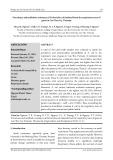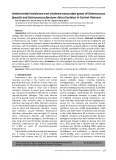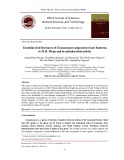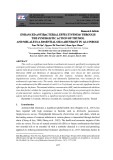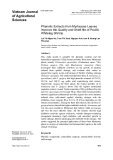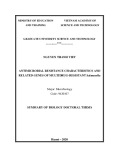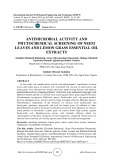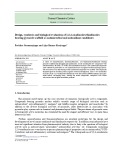The noncatalytic C-terminus of AtPOLK Y-family DNA polymerase affects synthesis fidelity, mismatch extension and translesion replication Marı´a Victoria Garcı´a-Ortiz, Teresa Rolda´ n-Arjona and Rafael R. Ariza
Departamento de Gene´ tica, Universidad de Co´ rdoba, Spain
Keywords Arabidopsis thaliana; base-pair mismatch; DNA damage; DNA replication; translesion DNA synthesis
region is essential
Correspondence R. R. Ariza, Departamento de Gene´ tica, Edificio Gregor Mendel, Campus de Rabanales s ⁄ n, Universidad de Co´ rdoba, 14071-Co´ rdoba, Spain Fax: +34 957 212 072 Tel: +34 957 218 979 E-mail: ge1roarr@uco.es
(Received 10 April 2007, accepted 4 May 2007)
doi:10.1111/j.1742-4658.2007.05868.x
to the replication fork,
Cell survival depends not only on the ability to repair damaged DNA but also on the capability to perform DNA replication on unrepaired or imperfect templates. Crucial to this process are specialized DNA polym- erases belonging to the Y family. These enzymes share a similar catalytic fold in their N-terminal region, and most of them have a less-well-con- served C-terminus which is not required for catalytic activity. Although this for appropriate localization and recruitment in vivo, its precise role during DNA synthesis remains unclear. Here we have compared the catalytic properties of AtPOLK, an Arabidopsis orthologue of mammalian pol j, and a truncated version lacking 193 amino acids from its C-terminus. We found that C-terminally truncated AtPOLK is a high-efficiency mutant protein, the DNA-binding capacity of which is not affected but it has higher catalytic efficiency and fidelity than the full-length enzyme. The truncated protein shows increased pro- pensity to extend mispaired primer termini through misalignment and enhanced error-free bypass activity on DNA templates containing 7,8-di- in addition to facilita- hydro-8-oxoGuanine. These results suggest that, ting recruitment the C-terminus of Y-family DNA polymerases may also play a role in the kinetic control of their enzymatic activity.
Cells are equipped not only with high-fidelity enzymes that accurately replicate the genome, but also with spe- cialized DNA polymerases that play essential functions in repair and ⁄ or replication of damaged DNA [1–3]. Many of these enzymes are structurally related and belong to the Y family of DNA polymerases, which includes four subfamilies represented by Escherichia coli DinB (Pol IV) and UmuC (Pol V), and Saccharo- myces cerevisiae pol g (Rad30) and Rev1 [4]. UmuC- like proteins have been identified exclusively in bacteria, and the Rad30 and Rev1 subfamilies contain only eukaryotic members. The DinB subfamily is the most phylogenetically diverse, with bacterial, archaean and eukaryotic proteins [4].
Members of the Y family contain 350–1200 amino- acid residues, but share five conserved sequence motifs distributed along the N-terminal part of the molecule. Crystal structures of this region in several Y-family polymerases have revealed a catalytic core with an archetypal DNA polymerase fold including finger, thumb and palm domains arranged in a classic ‘right hand-like’ configuration, and an extra domain known as little finger, polymerase-associated domain, or wrist domain [5]. Unlike replicative DNA polymerases, Y-family enzymes have an open solvent-accessible active site but lack proofreading exonuclease activity [2]. Consequently, they have some remarkable biochemical properties, such as low fidelity on undamaged DNA [6]
FEBS Journal 274 (2007) 3340–3350 ª 2007 The Authors Journal compilation ª 2007 FEBS
3340
Abbreviations PCNA, proliferating cell nuclear antigen, UBZ, ubiquitin-binding Zn-finger motif; 8-oxoG, 7,8-dihydro-8-oxoGuanine; edA, 1,N6-ethenoadenine.
M. V. Garcı´a-Ortiz et al. Role of C-terminus in AtPOLK DNA polymerase
and displacement of the replicative DNA polymerase [3,11].
these enzymes act
and the ability to synthesize DNA opposite-damaged templates by translesion synthesis [7]. The current hypothesis is that transiently at arrested replication forks to copy any faulty nucleotides and extend the resultant noncanonical primer–template pairs with varying degrees of accuracy, but give way to high-fidelity replication downstream of the arrest point [8].
Despite its important in vivo functions, the role of the C-terminal region of Y-family DNA polymerases during DNA synthesis remains unclear. We have previ- ously reported that the activity and processivity of AtPOLK, an Arabidopsis orthologue of mammalian pol j, are enhanced markedly upon deletion of 193 amino acids from its C-terminus [12]. AtPOLK is a plant Y-family DNA polymerase belonging to the DinB subfamily. The N-terminal half of AtPOLK shows the five conserved motifs (I–V) present in all Y-family DNA polymerases and an N-terminal extension unique to eukaryotic DinB orthologues, whereas its C-terminal half shows a much lower degree of sequence conserva- tion (Fig. 1A). In the C-terminal region, AtPOLK con- tains a putative ubiquitin-binding Zn-finger motif (UBZ), a predicted bipartite nuclear localization signal, and a candidate PCNA-interaction domain.
To better understand the role of
truncated
the
In addition to their conserved N-terminal catalytic core, most Y-family DNA polymerases have a C-ter- minal region with a low degree of sequence conserva- tion between members of the family [9]. This region is not essential for catalytic activity, but plays important roles in vivo through protein–protein interactions that mediate appropriate localization and recruitment [3]. Mammalian pols g, j and i contain a consensus prolif- erating cell nuclear antigen (PCNA)-binding PIP motif at their C-termini that is essential for their targeting to the replication machinery in vivo [3]. This region also contains novel ubiquitin-binding domains that are evo- lutionarily conserved in all Y-family polymerases and are required for their recruitment to replication factor- ies [10]. It has been proposed that binding of Y-family DNA polymerases to ubiquitinated PCNA via both the PIP motif and the ubiquitin-binding domains facili- to stalled replication forks tates
recruitment
their
the C-terminal domain of this Y-family DNA polymerase during DNA synthesis, we compared the catalytic properties of full-length AtPOLK and version (AtPOLKDC1–478). We found that deletion of the C-terminus increased the catalytic efficiency and fidelity of AtPOLK during synthesis on undamaged DNA
A
B
FEBS Journal 274 (2007) 3340–3350 ª 2007 The Authors Journal compilation ª 2007 FEBS
3341
Fig. 1. DNA polymerase activity of AtPOLK and AtPOLKDC. (A) Schematic diagram of AtPOLK (wt) and AtPOLKDC (DC) showing the regions of similarity to other DinB orthologues as shaded sections. The positions of motifs I–V, identified in all Y-family DNA polymerases, are shown. Letters x, y and z designate motifs that are characteristic of the DinB subfamily. The motif N is an N-terminal extension unique to eukaryotic DinB orthologues. The putative nuclear localization site (NLS), UBZ3 motif and PCNA-binding domain are also indicated. (B) DNA polymerase activity of full-length AtPOLK (wt) versus its C-terminally truncated version (DC) on various templates. Increasing concentrations (100, 300 and 500 nM) of AtPOLK or AtPOLKDC were assayed for their ability to extend a 5¢-end-labelled 21-nucleotide primer annealed to a 40-nucleotide template (100 nM). A portion of each substrate is shown on top. Lanes 1, 9, 17 and 25 contain no enzyme. Klenow (250 nM) was used as a positive control in lanes 8, 16, 24 and 32.
M. V. Garcı´a-Ortiz et al. Role of C-terminus in AtPOLK DNA polymerase
templates, enhanced its ability to extend mismatches through misalignment, and strongly influenced its trans- lesion activity through error-prone and error-free bypass.
Results
the full-length enzyme at all concentrations tested. These data are in agreement with our previous finding of a higher processivity of AtPOLKDC relative to the wild-type enzyme [12]. Thus, truncation of the 193 C-terminal amino acids stimulates the DNA polym- erase activity and processivity of AtPOLK on different DNA substrates.
DNA polymerase activity of wild-type and truncated AtPOLK
The C-terminally truncated AtPOLK DNA polymerase is not affected in DNA binding
for
that
The full-length and truncated AtPOLK were purified to homogeneity as described by Garcı´ a-Ortiz et al. [12]. AtPOLKDC retains amino acids 1–478, which encompass the five conserved motifs (I–V) present in all Y-family DNA polymerases, the x, y and z motifs that are unique to the DinB subfamily, and the N-ter- minal extension characteristic of the eukaryotic DinB orthologues (Fig. 1A). A structure-based alignment of AtPOLK with human pol j, Sulfolobus solfataricus Dpo4, Dbh, and E. coli DinB suggests the enzyme catalytic core is preserved in the C-terminally truncated enzyme (Supplementary material, Fig. S1).
In our previous analysis of AtPOLK, we found that the full-length enzyme had lower polymerization activity than the truncated version [12]. However, as the experi- ments were performed on a single primer–template substrate, we decided to test the enzymatic activity of both proteins on different substrates, each containing a different base pair at the primer–template junction.
We next examined whether the differences in polymer- ization activity between AtPOLK and AtPOLKDC could arise from differences in their relative binding affinities the primer–template DNA substrate. Wild-type and truncated AtPOLK were both assayed for their capacity to bind various DNA substrates using a gel electrophoretic mobility shift method (Fig. 2). First, we tested the ability of wild-type and truncated AtPOLK to bind single-stranded, double- stranded and template–primer DNA structures. When various labelled DNAs were incubated with either AtPOLK or AtPOLKDC, the formation of stable protein–DNA complexes could be detected as shifted bands after nondenaturing gel electrophoresis. As shown in Fig. 2A, both AtPOLK and AtPOLKDC preferentially bind template–primer DNA substrates or single-stranded DNA, and bind double-stranded DNA poorly. Binding to the primer–template structure results in a single retardation band (Fig. 2A,B), which might represent a protein–DNA interaction providing a stable polymerization-competent conformation of the primer terminus at the enzyme active site, such as that observed with other DNA polymerases [14]. As shown in Fig. 2B, binding of the primer–template structure to the truncated AtPOLK was essentially identical with that of the full-length protein. We found analogous results with other combinations of primer–template DNA (data not shown). Therefore, truncation of the 193 C-terminal amino acids of AtPOLK does not significantly affect its binding affinity to DNA in vitro. These results suggest that the C-terminal domain of AtPOLK is dispensable for DNA binding, although its presence negatively affects its DNA polymerization activity.
enzyme
Fidelity analysis of AtPOLK and AtPOLKnC
We next analysed the catalytic efficiency and fidelity of AtPOLK and AtPOLKDC during DNA synthesis. To determine the fidelity of both full-length and truncated AtPOLK, we analysed the steady state kinetics by measuring the incorporation of correct and incorrect
AtPOLK and AtPOLKDC proteins were assayed for DNA polymerase activity measuring extension of four 5¢-end-labelled 21-mer primers annealed to their corres- ponding 40-mer template (Fig. 1B). Both AtPOLK and AtPOLKDC synthesized DNA, extending the pri- mer to a size comparable to the full-length product generated by the Klenow fragment of E. coli DNA polymerase I (Fig. 1B). As reported for mammalian pol j [13], neither wild-type nor truncated AtPOLK efficiently copy to the end of the template, finishing one or two nucleotides before the terminus (Fig. 1B, and data not shown). We found that deletion of 193 residues at the C-terminus had a major effect on the enzymatic activity of the protein on all substrates. The polymerization activity of full-length AtPOLK was significantly lower than that of AtPOLKDC, requiring a fivefold higher concentration than the truncated polymerase to replicate fully a 40-nucleotide template. In addition, in all four substrates a range of incomplete extension products consistent with distribu- tive synthesis was seen in reaction mixtures containing the wild-type enzyme, represented by a stepladder pattern on the gel beginning with primer +1 dNMP. In contrast, AtPOLKDC showed longer products than
FEBS Journal 274 (2007) 3340–3350 ª 2007 The Authors Journal compilation ª 2007 FEBS
3342
M. V. Garcı´a-Ortiz et al. Role of C-terminus in AtPOLK DNA polymerase
A
B
Fig. 2. DNA-binding capacity of AtPOLK and AtPOLKDC. Enzymes were incubated with various labelled DNA molecules as described in Experimental procedures. After nondenaturing gel electrophoresis, enzyme–DNA complexes were identified by their retarded mobility com- pared with that of free DNA, as indicated. (A) DNA-binding affinity for different DNA substrates. Two concentrations (1.0 and 1.5 lM) of AtPOLK (wt) or AtPOLKDC (DC) were incubated with 0.5 lM each of labelled single-stranded, double-stranded or primer–template DNA sub- strates. (B) DNA-binding affinity for a primer–template DNA structure. Increasing amounts of AtPOLK or AtPOLKDC (0.5, 1.0 and 1.5 lM) were incubated with a labelled primer–template DNA substrate (0.5 lM).
used to calculate the catalytic efficiency (kcat ⁄ Km) (Table 1) and the frequency of deoxynucleotide mis- [finc ¼ (kcat ⁄ Km)incorrect ⁄ (kcat ⁄ Km)correct] incorporation opposite each of the four template bases (Fig. 3).
full-length AtPOLK, measured as
deoxynucleotides opposite each of the four template bases. A DNA polymerase extension assay was used to measure the rate of deoxynucleotide incorporation, cal- culated by dividing the amount of product formed by the reaction time. The observed rate was plotted as a function of the dNTP concentration and the data were fitted to the Michaelis–Menten equation. The apparent Km and Vmax steady state kinetic parameters for the incorporation of both correct and incorrect deoxy- nucleotides were obtained from each fitted curve and
AtPOLK and AtPOLKDC misincorporated dCTP opposite template A, C, and T, dTTP opposite tem- plate G and C, and dATP opposite template C. The fidelity of the frequency of deoxynucleotide misincorporation (finc), ranged from 2.3 · 10)3 (for the misincorporation of
)1Æmin)1)
Table 1. Steady-state kinetic parameters for AtPOLK and AtPOLKDC. Data are mean ± SE from at least two independent experiments. Only those combinations of template base and incoming nucleotide for which incorporation was detected are shown.
kcat (min)1) kcat ⁄ Km (lM Km (lM)
AtPOLK AtPOLK AtPOLK dNTP AtPOLKDC AtPOLKDC AtPOLKDC
0.024 ± 0.001 0.125 ± 0.010 0.057 ± 0.001 0.0038 ± 0.0004 0.059 ± 0.010 0.111 ± 0.005 0.119 ± 0.006 0.081 ± 0.001 52.60 ± 64.40 12.51 ± 3.59 83.30 ± 8.34 156.80 ± 85.80 390.46 ± 272.15 0.41 ± 0.08 28.25 ± 8.85 171.68 ± 45.03 4.6 · 10-4 1.0 · 10-2 6.8 · 10-4 2.4 · 10-5 1.5 · 10-4 0.27 4.2 · 10-3 4.7 · 10-4
0.157 ± 0.014 0.038 ± 0.001 0.152 ± 0.005 0.131 ± 0.003 2.61 ± 0.78 62.29 ± 24.38 0.13 ± 0.02 72.94 ± 9.23 6.0 · 10-2 6.1 · 10-4 1.17 1.8 · 10-3
0.207 ± 0.010 0.045 ± 0.003 0.145 ± 0.003 0.063 ± 0.003 4.70 ± 0.94 100.41 ± 46.48 0.69 ± 0.05 233.38 ± 36.95 4.4 · 10-2 4.5 · 10-4 2.1 · 10-1 2.7 · 10-4
FEBS Journal 274 (2007) 3340–3350 ª 2007 The Authors Journal compilation ª 2007 FEBS
3343
Template C dATP dGTP dTTP dCTP Template T dATP dCTP Template A dTTP dCTP Template G dTTP dCTP 0.022 ± 0.001 0.061 ± 0.004 0.131 ± 0.007 0.116 ± 0.006 29.16 ± 7.30 7.76 ± 1.60 10.07 ± 4.10 0.61 ± 0.11 7.6 · 10-4 7.9 · 10-3 1.3 · 10-2 1.9 · 10-1
M. V. Garcı´a-Ortiz et al. Role of C-terminus in AtPOLK DNA polymerase
a significant reduction in the apparent Km for the incoming nucleotide, whereas only minor differences were observed in kcat values. For example, the (cid:2) 30- fold increase in the efficiency of G insertion opposite the C template nucleotide was accompanied by a (cid:2) 30- fold decrease in the Km for G, whereas the kcat did not change significantly (Table 1).
These results collectively suggest that the C-terminal domain of AtPOLK negatively affects its catalytic effi- ciency for correct insertion, decreasing the fidelity of the enzyme.
The C terminus affects the relative contributions of direct extension and misalignment during mismatch extension
Fig. 3. Misincorporation frequencies for AtPOLK and AtPOLKDC. Steady-state assays were performed as described in Experimental procedures, and the kcat and Km parameters (Table 1) were used to calculate the frequency of deoxynucleotide incorporation (finc) by applying the equation finc ¼ (kcat ⁄ Km)incorrect ⁄ (kcat ⁄ Km)correct.
dCTP opposite template C) to 9.6 · 10)2 (for the mis- incorporation of dTTP opposite template G) (Fig. 3). We conclude that AtPOLK is a low-fidelity DNA polymerase, with error rates in the range of those of other Y-family DNA polymerases [6,15–19].
for
correct
efficiencies
nucleotides more
efficiently
The frequencies of deoxynucleotide misincorporation (finc) opposite four templates are higher for the full- length enzyme than for AtPOLKDC (Fig. 3). These ratios of in fidelity represent different differences catalytic incorrect and nucleotide insertion. As shown in Table 1, AtPOLKDC the inserted every correct nucleotide and most of incorrect did than AtPOLK. Thus, the higher fidelity exhibited by the truncated version of AtPOLK is not due to a decrease in the incorporation of wrong nucleotides but to a greater ability to insert the correct nucleotide. the higher
Interestingly,
catalytic
is
AtPOLK is able to extend primer-terminal mispairs [12]. Therefore, we examined the different abilities of AtPOLK and AtPOLKDC to extend mismatched primer–template termini on undamaged DNA. It has been previously reported that human pol j is able to extend a mispaired primer terminus by incorporating the next correct nucleotide (direct extension) or by misalignment of the template and primer nucleotides [20]. To explore the capacity of wild-type and trun- cated AtPOLK to extend mispaired primer termini by direct extension or via misalignment, we analysed the steady state kinetics to determine the catalytic efficiency of nucleotide incorporation following a mismatched template–primer terminus. Two suitable DNA substrates were used to discriminate between the two modes of mismatch extension (Table 2). Substrate I contains a mispaired G:T primer–template terminus followed by an A and a G in the two consecutive downstream template positions. In this substrate the G:T mispair can only be extended by the direct incorporation of a T opposite the next A in the identical with substrate I template. Substrate II except for the presence of a C in the first downstream
efficiency of truncated AtPOLK for the correct insertion opposite each of the four template bases primarily results from
)1Æmin)1)
Table 2. Steady-state kinetic parameters for G:T mispair extension by AtPOLK and AtPOLKDC. Data are mean ± SE from at least two inde- pendent experiments. ND, not detected.
kcat (min)1) Km (lM) kcat ⁄ Km (lM
AtPOLK AtPOLK AtPOLK Substrate Sequence dNTP AtPOLKDC AtPOLKDC AtPOLKDC
36.95 ± 10.93 dTTP Substrate I 5¢--GAG 0.029 ± 0.002 ND 0.123 ± 0.010 ND ND 49.00 ± 18.90 ND 7.8 · 10)4 ND 2.5 · 10)3 ND 3¢--CTTAGA- dATP, dGTP or dCTP Substrate II 5¢--GAG
FEBS Journal 274 (2007) 3340–3350 ª 2007 The Authors Journal compilation ª 2007 FEBS
3344
dGTP 3¢--CTTCGA- dCTP dATP 0.048 ± 0.003 0.073 ± 0.010 ND 0.088 ± 0.010 0.130 ± 0.004 ND 61.65 ± 36.69 181.95 ± 35.36 ND 80.41 ± 33.18 12.98 ± 1.82 ND 7.8 · 10)4 4.0 · 10)4 ND 1.1 · 10)3 1.0 · 10)2 ND or dTTP
M. V. Garcı´a-Ortiz et al. Role of C-terminus in AtPOLK DNA polymerase
template position. In this substrate the G:T mispair can be extended either by direct incorporation of a G opposite the next C in the template or by misalignment of the primer-terminal G with the next C followed by the incorporation of a C.
out respectively), whereas AtPOLKDC carried misalignment 10 times more efficiently than direct extension (efficiencies of 1.2 · 10)2 and 1.1 · 10)3, respectively). Although the two enzymes perform direct extension with comparable efficiencies, AtPOLKDC carries out extension through misalignment 25 times more efficiently than does AtPOLK. Again, this increase largely results from a significant reduction in the apparent Km for the incoming nucleotide, with minor differences in kcat values (Table 2). These results suggest that differences in catalytic efficiency for inser- tion of correct nucleotides may determine the relative contributions of direct extension and misalignment during mismatch extension carried out by Y-DNA polymerases.
Error-prone and error-free lesion bypass by wild-type and truncated AtPOLK
We incubated either AtPOLK or AtPOLKDC in the presence of DNA substrates I or II and different con- centrations of dATP, dGTP, dCTP or dTTP. The measured rate of nucleotide incorporation was plotted as a function of dNTP concentration, and kcat and Km values were determined as described in the previous section and in the Experimental procedures. As shown in Table 2, both wild-type and truncated AtPOLK extended the primer terminal G in DNA substrate I, but only by incorporation of T, which is the next cor- rect nucleotide. In contrast, both enzymes incorporated either G or C when incubated with substrate II, which can realign the mismatched primer terminus using the neighbouring complementary templating base C. Thus, both AtPOLK and AtPOLKDC are able to extend a mispaired primer terminus, by either direct extension or misalignment of the template and primer nucleo- tides.
To examine the relative aptitudes of wild-type and truncated AtPOLK to bypass DNA lesions, we ana- lysed their ability to replicate from templates contain- ing a single 7,8-dihydro-8-oxoGuanine (8-oxoG), a single 1,N6-ethenoadenine (edA), or an abasic site (Fig. 4A). We found that AtPOLK is unable to bypass the abasic site or the edA adduct, but is able to insert nucleotides opposite the 8-oxodG lesion and moder- ately extend from the resulting primer end (Fig. 4A,
Interestingly, however, both proteins use these two modes of mispair extension to different degrees. Exten- sion through misalignment is performed by AtPOLK with a similar efficiency to extension by direct incorporation (efficiencies of 4 · 10)4 and 7.8 · 10)4,
A
B
FEBS Journal 274 (2007) 3340–3350 ª 2007 The Authors Journal compilation ª 2007 FEBS
3345
Fig. 4. DNA synthesis by AtPOLK and AtPOLKDC on templates containing 8-oxoG, edA, or an abasic site. (A) A 5¢-end-labelled 21-nucleotide primer was annealed to a 40-nucleotide oligonucleotide template containing G (lanes 1, 2 and 6), 8-oxoG (lanes 3 and 7), edA (lanes 4 and 8), or an abasic site (lanes 5 and 9) at the position indicated by X. AtPOLK (wt, 500 nM) or AtPOLKDC (DC,100 nM) was incubated with the DNA substrate (100 nM) in the presence of each of four dNTPs. The reaction mixture in lane 1 contained no enzyme. (B) Identification of nucleotides incorporated opposite 8-oxoG by AtPOLK and AtPOLKDC. Reactions were carried out in the presence of each dNTP individually (A, T, G, C) or all four dNTPs (N4). Reaction mixtures in lanes 7 and 14 contained Klenow enzyme (250 nM) with all four dNTPs. The reaction mixture in lane 1 contained no enzyme.
M. V. Garcı´a-Ortiz et al. Role of C-terminus in AtPOLK DNA polymerase
Table 3. Steady-state kinetic parameters of nucleotide insertion reactions opposite 8-oxoG template residues by AtPOLK and AtPOLKDC. Data are mean ± SE from at least two independent experiments.
1Æmin)1)
Relative incorporation efficiency kcat (min)1) Km (lM) kcat ⁄ Km (lM
AtPOLK AtPOLK DNA substrate Incoming nucleotide AtPOLKDC AtPOLKDC AtPOLK AtPOLKDC AtPOLK AtPOLKDC
dCTP 0.061 ± 0.04 0.116 ± 0.006 1 7.76 ± 1.60 0.61 ± 0.11 7.9 · 10)3 1.9 · 10)1 1
dCTP 0.17 0.105 ± 0.006 0.137 ± 0.004 49.79 ± 8.06 4.27 ± 0.69 2.1 · 10)3 3.2 · 10)2 0.27
dATP 0.110 ± 0.01 0.138 ± 0.04 0.19 24.40 ± 8.42 3.72 ± 0.29 4.5 · 10)3 3.7 · 10)2 0.57 Insertion opposite G 5’---GTAGAG 3’---CATCTCGGA- Insertion opposite 8-oxoG 5’---GTAGAG 3’---CATCTCGGA- 8’-oxo
synthesis in undamaged DNA. The relative incorpor- ation efficiency to the incorporation of a C opposite undamaged G ranged from 0.17, for insertion of C opposite 8-oxodG by AtPOLKDC, to 0.57, for inser- tion of A opposite 8-oxoG by ATPOLK.
lane 3). AtPOLKDC showed the same bypass specifici- ty as AtPOLK, being blocked by the abasic site and the edA adduct, but not by the 8-oxoG lesion. How- ever, after insertion opposite 8-oxodG, it performed extension from the 3¢-primer terminus with signifi- cantly higher efficiency than the wild-type enzyme (Fig. 4A, lane 7).
Interestingly, the ratio of the dATP:dCTP insertion was different in the two proteins. AtPOLK showed twice the relative incorporation efficiency for A oppos- ite 8-oxodG than for C (0.57 versus 0.27). However, AtPOLKDC inserted both A and C with similar effi- ciency (0.19 and 0.17, respectively). This discrepancy in the ratio of the dATP:dCTP insertion between the two proteins mainly arises from differences in the apparent Km values for dATP or dCTP. Whereas AtPOLK shows twice the Km for dCTP as for dATP, similar values were observed for both deoxynucleotides with AtPOLKDC (Table 3).
The miscoding potential of 8-oxoG arises from its ability to form stable base pairs with either a C or an A residue [21]. To identify the nucleotide incorporated opposite 8-oxoG, we performed DNA synthesis assays with dATP, dCTP, dGTP or dTTP individually. As shown in Fig. 4B, both AtPOLK and AtPOLKDC inserted either A or C opposite 8-oxoG. Primer exten- sion was not detected with dTTP and dGTP. Klenow was used as a control, and, as previously reported [21,22], it was strongly inhibited at chain extension at template positions 5¢- to the modified base (Fig. 4B, lanes 7 and 13).
Therefore, although both wild-type and truncated AtPOLK are able to perform either error-free or error- prone bypass of 8-oxoG, the full-length protein shows a preference for the latter given its proclivity towards A insertion. On the other hand, truncation of the C-terminal domain increases the bypass efficiency and decreases the efficiency of A insertion, thus reducing mutagenic translesion synthesis. Taken together these results suggest that the presence of the C terminus affects the relative contributions of error-free and error-prone bypass activity of AtPOLK.
Discussion
To measure the ratio of dATP:dCTP incorporation during the bypass of 8-oxoG, we measured the steady- state kinetic parameters of nucleotide insertion oppos- ite the lesion. The kinetics of insertion of dATP or dCTP opposite 8-oxoG were determined as a function of deoxynucleotide concentration under steady-state conditions (Table 3). The apparent steady-state kcat and Km values for each nucleotide incorporation were determined as described in Experimental procedures, and the relative incorporation efficiency was calculated as the ratio of the efficiency (kcat ⁄ Km) of incorrect nucleotide incorporated to the efficiency (kcat ⁄ Km) of correct nucleotide incorporated (Table 3).
As indicated by the kcat ⁄ Km values in Table 3, AtPOLK incorporated either A or C opposite 8-oxoG lesions less efficiently than did the truncated protein. The higher catalytic efficiency of AtPOLKDC resulted primarily from a decrease in the apparent Km for the incoming dNTP, as previously observed during DNA
The mutagenic potential of Y-family DNA poly- merases obliges cells to regulate their access to DNA, specifically recruiting them when and where they are needed. The ‘DNA polymerase switch model’ postu- lates a transient replacement of the replicative DNA polymerase in the vicinity of the lesion by one or several error-prone polymerases before resumption of
FEBS Journal 274 (2007) 3340–3350 ª 2007 The Authors Journal compilation ª 2007 FEBS
3346
M. V. Garcı´a-Ortiz et al. Role of C-terminus in AtPOLK DNA polymerase
enzyme. These results are in agreement with a previous study reporting that finc of a number of different DNA polymerases correlates inversely with their catalytic effi- ciency for correct nucleotide insertion, which thus implies that fidelity is primarily governed by the ability to insert the correct nucleotide [27].
high-fidelity replication [23]. Current understanding of this process favours the idea that switching is modu- lated via interaction of the C-terminal domain of Y-family DNA polymerases with the replication proc- essivity clamp PCNA. In this model, PCNA might function as a ‘tool-belt’, enabling efficient access to the blocking lesion by different polymerases [24].
rate-limiting
conformational
changes
The higher catalytic efficiency of truncated AtPOLK for correct insertion opposite each of the four template bases is achieved primarily by a reduction in the apparent Km for the nucleotide. It is possible that dele- tion of the C-terminal 193 amino acids of AtPOLK modifies the conformation of the active site, causing higher affinity of the enzyme for the nucleotide. How- ever, it is important to recall that Km cannot be corre- lated to initial dNTP binding with certainty, and perhaps the effect of the C-terminal truncation instead that affects immediately follow dNTP binding [28]. Interestingly, it has been reported that PCNA binding to the C-terminal region of Y-family polymerases stimulates their efficiency to incorporate nucleotides correctly, primarily through a reduction in the apparent Km of the reaction [29,30]. It has been proposed that this reduction is due to a PCNA-induced conformational change in the polymerase active site [2]. The results reported here are consistent with a possible role of the C-terminus in modulating the conformational state of the enzyme active site, raising the possibility that protein–protein interactions affecting this region may kinetically control the activity of Y polymerases.
Despite the well-documented function of the C-ter- minus in polymerase targeting and recruitment, our its role in Y-family DNA poly- understanding of merase catalytic activity is still limited. Efforts to relate the enzymatic properties of Y-family DNA poly- merases to their structural characteristics have focused on the catalytic core, neglecting the poorly conserved C-terminal region. To our knowledge, no detailed kin- etic analysis comparing full-length and C-terminally truncated Y-DNA polymerases has been previously reported. However, there have been conflicting reports about the effect of C-terminal truncation in eukaryotic DinB orthologues on enzymatic activity. A protein from amino acids 19–526, which lacks the last 344 amino acids of human pol j, has been reported to possess a DNA polymerase activity equivalent to that of the wild-type enzyme [25]. In contrast, another truncated human pol j containing residues 1–562 shows similar activity but reduced processivity com- pared with the full-length protein [26]. We have previ- ously reported that the DNA polymerase activity and processivity of AtPOLK is markedly enhanced upon deletion of 193 amino acids from its C-terminus [12]. Differences between AtPOLK and human pol K C-ter- minal domains may be responsible for the discrepancy observed between mammalian and plant proteins. Human pol j, for example, contains two UBZs of the C2HC type (UBZ4) at their C-terminus [10], whereas AtPOLK shows a single UBZ domain of the C2H2 type (UBZ3) (Fig. S1).
Here, we have made a detailed comparison of the catalytic properties of both the full-length AtPOLK and its C-terminally truncated counterpart. We found that truncation of the AtPOLK C-terminus produced a high-efficiency mutant protein with increased fidelity. The DNA-binding capacity of the truncated protein was not affected, as both AtPOLK and AtPOLKDC displayed similar affinities for a primer–template struc- ture. This result argues against the possibility that the full-length protein does not fold properly, resulting in a large fraction of inactive protein.
Deletion of the C-terminus also has important conse- quences during mismatch extension, causing a propen- sity for the truncated enzyme to extend mispaired primer termini through misalignment rather than by direct extension. It is important to note that the confor- mation of the primer–template junction must be quite different in both circumstances. The enzyme must accommodate a mispaired primer–template terminus during direct extension, whereas a paired terminus is available after misalignment. In fact, and as we previ- ously observed with incorporation of correct nucleotides after properly paired prime-template termini, the higher efficiency of AtPOLKDC at extending by misalignment essentially reflects an increase in the catalytic efficiency for insertion of a ‘correct’ C opposite the second con- secutive templating base. Therefore, the kinetic control of DNA polymerase activity, perhaps achieved through protein–protein interactions via the C-terminus, may determine the relative contributions of direct incorpor- ation and misalignment during mismatch extension carried out by Y-family DNA polymerases.
The lower fidelity of wild-type AtPOLK results not from enhanced catalytic efficiency for misincorporation relative to the C-terminally truncated enzyme but rather from a lower catalytic efficiency for Watson–Crick incorporations than with the C-terminally truncated
We found that the ability of AtPOLK to bypass 8-oxoG is also influenced by its C-terminus. Most
FEBS Journal 274 (2007) 3340–3350 ª 2007 The Authors Journal compilation ª 2007 FEBS
3347
M. V. Garcı´a-Ortiz et al. Role of C-terminus in AtPOLK DNA polymerase
DNA polymerase assays
replicative DNA polymerases preferentially insert A opposite 8-oxodG [21], causing G:C fi T:A transver- sions [31]. Insertion preferences among Y-family DNA polymerases vary considerably. Yeast and human pol g [32,33] and archaean Dpo4 [34,35] preferentially insert C opposite the lesion. In contrast, human pol j inserts A more efficiently than C opposite 8-oxodG [36–38], and human pol i is significantly blocked by the lesion [39,40]. We found that AtPOLK shows a rel- ative incorporation efficiency for A opposite 8-oxodG that is twice that of C. However, AtPOLKDC inserted both A and C with similar efficiency. On the other hand, the truncated protein showed (cid:2) 10-fold higher catalytic efficiency than the wild-type enzyme for nucleotide insertion opposite 8-oxoG. Thus, deletion of the C-terminus increases the bypass efficiency of the protein but decreases its potential for mutagenic translesion synthesis.
The standard DNA polymerase reaction mixture (10 lL) contained 20 mm potassium phosphate buffer (pH 7.0), 4 mm MgCl2, 0.4 mgÆmL)1 BSA, 8% glycerol, 12.5 mm dithiothreitol, and 100 lm each deoxynucleotide (dGTP, dATP, dTTP, dCTP), except where noted. Substrate and enzyme concentrations are specified in the figure legends and text. Reactions were carried out at 30 (cid:2)C for 30 min unless indicated otherwise and terminated by addition of 10 lL formamide gel loading buffer (90% formamide, 1 · Tris ⁄ borate ⁄ EDTA buffer). After denaturation at 95 (cid:2)C for 10 min, products were resolved by electrophor- (acryl- esis on a denaturing 15% polyacrylamide gel amide ⁄ bisacrylamide ¼ 19 : 1, 1 · Tris ⁄ borate ⁄ EDTA, 7 m urea) (Owl Electrophoresis System, Portsmouth, NH) pre- run for 30 min at 450 V. Fluorescein-labelled DNA was visualized using the blue fluorescence mode of the FLA- 5100 imager and analysed using multigauge software (Fujifilm, Tokyo, Japan).
Analysis of steady-state kinetics
Taken together, the results reported here suggest that the 193 C-terminal amino acids of AtPOLK may modulate the catalytic activity of the protein, affecting its catalytic efficiency and fidelity during synthesis on undamaged DNA templates, its capacity to extend mismatches through misalignment, and its bypass effi- ciency through error-prone and error-free bypass. Given the requirement for kinetically controlling error- prone DNA polymerases when they are in the replica- tion fork, the possibility exists that, in addition to function in DNA polymerase targeting and recruit- ment, the C-terminus of Y-family DNA polymerases also plays a role in modulating their enzymatic activity through protein–protein interactions. Elucidation of the precise role of the C-terminal domain in Y-family DNA polymerases will need more experimental work and additional structural data on full-length enzymes.
Experimental procedures
AtPOLK or AtPOLKnC (50–100 nm) was incubated with 100–200 nm primer–template substrate in the presence of increasing concentrations of a single deoxynucleotide. After incubation for 15 min at 30 (cid:2)C under standard DNA polymerase assay conditions, reactions were stopped and run on a 15% polyacrylamide gel, containing 7 m urea, to separate the unextended and extended DNA primers. Integ- rated gel band intensities were measured using a FLA-5100 imager and multigauge software. The observed rate of nucleotide incorporation (extended primer) was plotted as a function of dNTP concentration. A Michaelis–Menten curve, where v ¼ (Vmax[dNTP]) ⁄ (Km + [dNTP]), was fitted to the data by nonlinear regression (sigmaplot; Systat Software, San Jose, CA). The kcat (Vmax ⁄ [enzyme]) and Km steady-state parameters defining the fitted curve were used to calculate the frequency of deoxynucleotide incorporation (finc) by applying the equation finc ¼ (kcat ⁄ Km)incorrect ⁄ (kcat ⁄ Km)correct.
Proteins and DNA substrates
Electrophoretic mobility-shift assay
used
oligonucleotide
21-mer
primer
Standard binding reactions were performed in a volume of 10 lL containing 25 mm potassium phosphate buffer (pH 7.4), 0.2 mgÆmL)1 BSA, 5 mm dithiothreitol, 2.5% glycerol, 15 mm KCl, 20 mm NaCl, 5¢-fluorescein-labelled DNA (500 nm), 1 ng poly(dI-dC) and the indicated amounts of protein. Reaction mixtures were incubated on ice for 15 min before being loaded on to 8% nondenaturing polyacrylamide gels (acrylamide ⁄ bisacrylamide, 37.5 : 1) and electrophoresed at 200 V at 4 (cid:2)C in 1 · Tris/acetate/ EDTA buffer.
His-tagged AtPOLK and AtPOLKDC proteins were expressed in E. coli and purified as described previously (Supplementary material, [12]. Oligonucleotides Table S1) were synthesized by Operon and were purified by PAGE before use. Double-stranded DNA substrates were prepared by mixing a 1.5-lm solution of a 5¢-fluorescein- (upper-strand labelled oligonucleotide) with a 1.0-lm solution of an unlabelled 40-nucleotide oligomer template (lower-strand oligonucleo- tide), heating to 95 (cid:2)C for 5 min and slowly cooling to room temperature. Ultrapure dNTPs and Klenow enzyme were obtained from Roche (Basel, Switzerland).
FEBS Journal 274 (2007) 3340–3350 ª 2007 The Authors Journal compilation ª 2007 FEBS
3348
M. V. Garcı´a-Ortiz et al. Role of C-terminus in AtPOLK DNA polymerase
Acknowledgements
active site. Mutational analysis of conserved motif TX2GR. J Biol Chem 269, 30030–30038.
This research was supported by grant BMC2003-04350 from the Ministerio de Educacio´n y Ciencia, Spain, to RRA. Financial support from the Junta de Andalucı´a is also gratefully acknowledged.
15 Johnson RE, Washington MT, Haracska L, Prakash S & Prakash L (2000) Eukaryotic polymerases i and f act sequentially to bypass DNA lesions. Nature 406, 1015–1019.
References
16 Johnson RE, Washington MT, Prakash S & Prakash L (2000) Fidelity of human DNA polymerase g. J Biol Chem 275, 7447–7450.
17 Washington MT, Johnson RE, Prakash S & Prakash L (1999) Fidelity and processivity of Saccharomyces cerevisiae DNA polymerase g. J Biol Chem 274, 36835–36838.
1 Friedberg EC (2005) Suffering in silence: the tolerance of DNA damage. Nat Rev Mol Cell Biol 6, 943–953. 2 Prakash S, Johnson RE & Prakash L (2005) Eukary- otic translesion synthesis DNA polymerases: specificity of structure and function. Annu Rev Biochem 74, 317–353.
3 Lehmann AR (2006) Translesion synthesis in mamma-
18 Johnson RE, Prakash S & Prakash L (2000) The human DINB1 gene encodes the DNA polymerase Polh. Proc Natl Acad Sci USA 97, 3838–38343.
lian cells. Exp Cell Res 312, 2673–2676.
19 Zhang Y, Yuan F, Xin H, Wu X, Rajpal DK, Yang D & Wang Z (2000) Human DNA polymerase j synthes- izes DNA with extraordinarily low fidelity. Nucleic Acids Res 28, 4147–4156.
4 Ohmori H, Friedberg EC, Fuchs RP, Goodman MF, Hanaoka F, Hinkle D, Kunkel TA, Lawrence CW, Livneh Z, Nohmi T, et al. (2001) The Y-family of DNA polymerases. Mol Cell 8, 7–8.
20 Wolfle WT, Washington MT, Prakash L & Prakash S
5 Yang W (2005) Portraits of a Y-family DNA poly-
merase. FEBS Lett 579, 868–872.
6 Kunkel TA (2004) DNA replication fidelity. J Biol
Chem 279, 16895–16898.
(2003) Human DNA polymerase j uses template-primer misalignment as a novel means for extending mispaired termini and for generating single-base deletions. Genes Dev 17, 2191–2199.
7 Woodgate R (1999) A plethora of lesion-replicating
21 Shibutani S, Takeshita M & Grollman AP (1991)
DNA polymerases. Genes Dev 13, 2191–2195.
Insertion of specific bases during DNA synthesis past the oxidation-damaged base 8-oxodG. Nature 349, 431–434.
8 Friedberg EC, Walker GC, Siede W, Wood RD, Schultz RA & Ellenberger T (2006) DNA Repair and Mutagen- esis, 2nd edn. ASM Press, Washington, D.C.
9 Johnson RE, Washington MT, Prakash S & Prakash L (1999) Bridging the gap: a family of novel DNA poly- merases that replicate faulty DNA. Proc Natl Acad Sci USA 96, 12224–12226.
22 Miller H & Grollman AP (1997) Kinetics of DNA polymerase I (Klenow fragment exo–) activity on damaged DNA templates: effect of proximal and distal template damage on DNA synthesis. Biochemistry 36, 15336–15342.
10 Bienko M, Green CM, Crosetto N, Rudolf F, Zapart
G, Coull B, Kannouche P, Wider G, Peter M, Lehmann AR, Hofmann K & Dikic I (2005) Ubiquitin-binding domains in Y-family polymerases regulate translesion synthesis. Science 310, 1821–1824.
23 Cordonnier AM & Fuchs RP (1999) Replication of damaged DNA: molecular defect in xeroderma pigmentosum variant cells. Mutat Res 435, 111–119. 24 Pages V & Fuchs RP (2002) How DNA lesions are turned into mutations within cells? Oncogene 21, 8957–8966.
25 Uljon SN, Johnson RE, Edwards TA, Prakash S,
11 Plosky BS, Vidal AE, de Henestrosa AR, McLenigan MP, McDonald JP, Mead S & Woodgate R (2006) Controlling the subcellular localization of DNA polym- erases i and g via interactions with ubiquitin. EMBO J 25, 2847–2855.
Prakash L & Aggarwal AK (2004) Crystal structure of the catalytic core of human DNA polymerase kappa. Structure (Camb) 12, 1395–1404.
12 Garcı´ a-Ortiz MV, Ariza RR, Hoffman PD, Hays JB & Roldan-Arjona T (2004) Arabidopsis thaliana AtPOLK encodes a DinB-like DNA polymerase that extends mispaired primer termini and is highly expressed in a variety of tissues. Plant J 39, 84–97.
26 Ohashi E, Bebenek K, Matsuda T, Feaver WJ, Gerlach VL, Friedberg EC, Ohmori H & Kunkel TA (2000) Fidelity and processivity of DNA synthesis by DNA polymerase j, the product of the human DINB1 gene. J Biol Chem 275, 39678–39684.
13 Gerlach VL, Feaver WJ, Fischhaber PL & Friedberg
27 Beard WA, Shock DD, Vande Berg BJ & Wilson SH
EC (2001) Purification and characterization of pol j, a DNA polymerase encoded by the human DINB1 gene. J Biol Chem 276, 92–98.
(2002) Efficiency of correct nucleotide insertion governs DNA polymerase fidelity. J Biol Chem 277, 47393– 47398.
28 Showalter AK, Lamarche BJ, Bakhtina M, Su MI,
14 Mendez J, Blanco L, Lazaro JM & Salas M (1994) Pri- mer-terminus stabilization at the /29 DNA polymerase
Tang KH & Tsai MD (2006) Mechanistic comparison
FEBS Journal 274 (2007) 3340–3350 ª 2007 The Authors Journal compilation ª 2007 FEBS
3349
37 Zhang Y, Yuan F, Wu X, Wang M, Rechkoblit O,
of high-fidelity and error-prone DNA polymerases and ligases involved in DNA repair. Chem Rev 106, 340–360.
29 Haracska L, Kondratick CM, Unk I, Prakash S &
Taylor JS, Geacintov NE & Wang Z (2000) Error-free and error-prone lesion bypass by human DNA polymerase j in vitro. Nucleic Acids Res 28, 4138–4146.
Prakash L (2001) Interaction with PCNA is essential for yeast DNA polymerase g function. Mol Cell 8, 407–415.
38 Jaloszynski P, Ohashi E, Ohmori H & Nishimura S (2005) Error-prone and inefficient replication across 8-hydroxyguanine (8-oxoGuanine) in human and mouse ras gene fragments by DNA polymerase j. Genes Cells 10, 543–550.
39 Zhang Y, Yuan F, Wu X, Taylor JS & Wang Z (2001)
30 Haracska L, Unk I, Johnson RE, Phillips BB, Hurwitz J, Prakash L & Prakash S (2002) Stimulation of DNA synthesis activity of human DNA polymerase j by PCNA. Mol Cell Biol 22, 784–791.
31 Moriya M (1993) Single-stranded shuttle phagemid for
Response of human DNA polymerase i to DNA lesions. Nucleic Acids Res 29, 928–935.
40 Johnson RE, Haracska L, Prakash L & Prakash S (2006) Role of hoogsteen edge hydrogen bonding at template purines in nucleotide incorporation by human DNA polymerase i. Mol Cell Biol 26, 6435–6441.
mutagenesis studies in mammalian cells: 8-oxoGuanine in DNA induces targeted GÆC fi TÆA transversions in sim- ian kidney cells. Proc Natl Acad Sci USA 90, 1122–1126. 32 Haracska LYuSL, Johnson RE, Prakash L & Prakash S (2000) Efficient and accurate replication in the presence of 7,8-dihydro-8-oxoGuanine by DNA polymerase g. Nat Genet 25, 458–461.
M. V. Garcı´a-Ortiz et al. Role of C-terminus in AtPOLK DNA polymerase
Supplementary material
is available
33 Yuan F, Zhang Y, Rajpal DK, Wu X, Guo D, Wang M, Taylor JS & Wang Z (2000) Specificity of DNA lesion bypass by the yeast DNA polymerase g. J Biol Chem 275, 8233–8239.
alignment
sequence
34 Rechkoblit O, Malinina L, Cheng Y, Kuryavyi V, Bro- yde S, Geacintov NE & Patel DJ (2006) Stepwise trans- location of Dpo4 polymerase during error-free bypass of an oxoG lesion. PLoS Biol 4, e11.
The following supplementary material online: Fig. S1. Structure-based of AtPOLK, human pol j, S. solfataricus Dpo4, Dbh, and E. coli DinB. Table S1. DNA sequence of oligonucleotides used as substrates.
This material is available as part of the online article
from http://www.blackwell-synergy.com
35 Zang H, Irimia A, Choi JY, Angel KC, Loukachevitch LV, Egli M & Guengerich FP (2006) Efficient and high fidelity incorporation of dCTP opposite 7,8-dihydro-8- oxodeoxyguanosine by Sulfolobus solfataricus DNA polymerase Dpo4. J Biol Chem 281, 2358–2372. 36 Haracska L, Prakash L & Prakash S (2002) Role of
Please note: Blackwell Publishing is not responsible for the content or functionality of any supplementary materials supplied by the authors. Any queries (other than missing material) should be directed to the corres- ponding author for the article.
human DNA polymerase j as an extender in translesion synthesis. Proc Natl Acad Sci USA 99, 16000–16005.
FEBS Journal 274 (2007) 3340–3350 ª 2007 The Authors Journal compilation ª 2007 FEBS
3350








